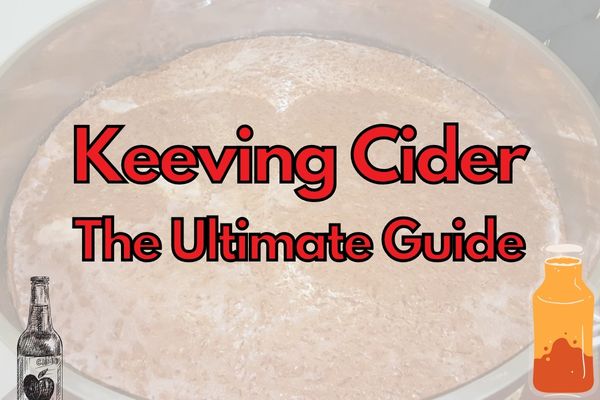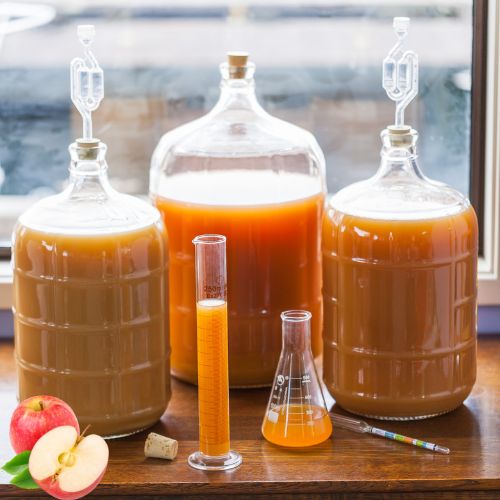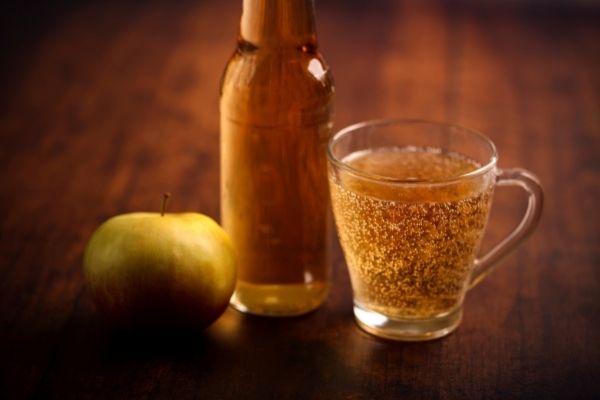If you’re looking to up your home brewing game, cider is the way to go! Home brewing cider can be a delicious and rewarding experience – especially if done the French way.
To brew authentic French-style hard ciders, it’s essential to use high quality apples from France as well as wild yeast for spontaneous fermentation and applying keeving techniques for the most authentic results!
The process also involves keeving and natural carbonation techniques that are unique compared with other methods of home brewing. In this blog post we’ll explore all these aspects in detail so you too can make exquisite hard ciders at home like a pro!
French Cider Apples
French cider apples are a special type of apple used to make hard cider. These apples have intense flavor profiles and come in four main varieties: bitter, bittersweet, sweet, and sharp.

Bitter Varieties: Bitter French cider apples include Domaine, Frequin Rouge, Mettais, and Moulin a Vent. These tart-tasting fruits add complexity to the final product. They are often blended with other types of apples for balance.
Bittersweet Varieties: Bittersweet French cider apples provide sweetness as well as acidity to the finished beverage. Popular varieties include Bedan, Binet Rouge, Bisquet Noël des Champs and Saint-Martin. The higher sugar content helps contribute to natural carbonation during fermentation process when making hard cider from these fruit varieties.
Sweet Varieties: Sweet French cider apple varieties such as Germaine and Rouge Duret bring additional sweetness without adding too much acidity or tannins into the mix – perfect for creating light-bodied ciders that still pack plenty of flavor!
Sharp Varieties: Rambault and René Martin are two popular sharp French cider apple varietals that offer an intense sourness along with subtle notes of spice or citrus zestiness on the palate – ideal for making complex dry ciders with lots of character!
Finding quality French Cider Apples can be challenging depending on where you live; however, many online retailers specialize in selling these specialty fruits at reasonable prices so it is worth doing some research if you want to try your hand at crafting traditional European style ciders using only authentic ingredients.
French cider apples are an essential ingredient for brewing traditional hard ciders. Next, we’ll look at the process of making your own hard cider from scratch.
Wild Yeast Fermentation
Wild yeast fermentation is an important part of making French cider. It involves allowing the natural yeasts present in the environment to ferment your cider, rather than adding a commercial yeast strain. This process gives the cider a unique flavor and complexity that can’t be achieved with other methods.

The first step in wild yeast fermentation is to collect apples from trees that are known for producing good quality ciders, such as those found in France’s Normandy region. These apples should be ripe and free of any blemishes or rot. Once collected, they should be crushed into a pulp using either a press or grinder before being placed into containers for fermentation.
Next, it’s time to encourage the wild yeasts to begin fermentation. The best way to do this is by introducing oxygen-rich air into the container while keeping it covered so no foreign bacteria can enter and spoil your batch of cider. After several days, you will start seeing bubbles forming on top of your mixture which indicates that wild yeast has begun working its magic!
Not you will need to ensure an oxygen-free environment so alcohol fermentation can take place.
Once active fermentation begins, you will need to monitor your progress closely and adjust temperatures accordingly if needed (ideally between 65°F – 75°F). You may also need to stir or aerate your mixture every few days depending on how vigorous the activity is inside the container.
When all signs point towards completion (no more bubbling), you can then transfer your finished product into bottles where it will naturally carbonate over time, thanks again to those helpful little wild yeasts.
From here on out, it’s just a matter of waiting patiently until you have reached desired levels of sweetness and carbonation before finally enjoying what could very well be one delicious glassful after another… Cheers.
Wild yeast fermentation is an exciting way to make cider that can create unique flavors and aromas, and it is important to understand the process before moving on to other steps in home brewing cider.
Main Takeaway: Wild yeast fermentation is an important part of making French cider. It involves collecting ripe apples from trees known for producing good quality ciders, introducing oxygen-rich air to introduce the wild yeasts, monitoring progress and adjusting temperatures accordingly, stirringaerating mixture every few days, and finally transferring finished product into bottles for natural carbonation. The result? Deliciously complex flavors that can’t be achieved with other methods!
Keeving
Keeving is a traditional French and Irish method of cider brewing that involves starving the yeast from nutrients to make a sweeter, lightly sparkling cider. This technique has been used for centuries in France and Ireland, but is now gaining popularity among home brewers.
The process begins with selecting the right apples for your brew. Cider apples are high in tannins and sugars, which will give your finished product its unique flavor profile. You can find these special types of apples at most local orchards or specialty stores. Once you have selected your apples, it’s time to start fermenting them into cider!

Next comes the keeving process itself. The goal here is to remove as much sugar from the juice as possible while still preserving some sweetness in the final product. To do this, you need to add pectinase enzymes to break down any pectin molecules present in the apple juice before fermentation begins. This step helps reduce bitterness and allows more of the natural sugars found in apple juice to remain intact during fermentation—which results in a sweeter end result!
Once all of this has been done, it’s time for wild yeast fermentation—a key part of keeving that gives your cider its signature light carbonation and fruity flavor notes without adding additional sugar or artificial ingredients like sulfites or preservatives. Wild yeasts are naturally occurring organisms found on fruit skins that help convert sugars into alcohol during fermentation; however they also require oxygen exposure so be sure not to seal off your container too tightly when fermenting!
Finally, once all of these steps have been completed successfully you should have yourself a delicious batch of sweet-tart hard cider ready for bottling or drinking. With just a few simple tips and tricks under your belt, you can create an amazing craft beverage using only natural ingredients – no added chemicals required. So go ahead: grab some fresh-pressed apple juice and get started on crafting up something truly special with keeving today.
Keeving is an ancient method of cider-making that produces a naturally sweet, low-alcohol beverage. Now let’s take a look at the ingredients and equipment needed for home brewing cider.
Main Takeaway: Keeving is a traditional method of cider brewing that produces a sweet, lightly sparkling beverage. Home brewers can use this technique to craft their own unique ciders with natural ingredients and no added chemicals. The process involves selecting the right apples for your brew, adding pectinase enzymes to break down pectin molecules, wild yeast fermentation for carbonation and flavor notes, and bottling or drinking the final product. With just a few simple steps you can create an amazing craft beverage – so get started today!
Natural Carbonation
Natural carbonation is a process of adding bubbles to cider or beer without the use of forced carbon dioxide. This method of carbonation relies on the natural fermentation process and can be used for both hard ciders and beers.
When making hard cider, the yeast will consume sugars in the juice, releasing alcohol and carbon dioxide as byproducts. The CO2 gas produced during fermentation gets trapped in solution within the liquid due to its low solubility at cooler temperatures. As long as there are still fermentable sugars present, more CO2 will continue to be produced until it reaches equilibrium with atmospheric pressure. When this happens, you have naturally-carbonated cider!
Wild yeasts can also contribute to natural carbonation when brewing beer. Wild yeasts are found naturally in fruits such as apples which makes them ideal for producing traditional ciders that rely on wild yeast fermentation instead of commercial brewers’ yeast strains like Saccharomyces cerevisiae (ale) or Saccharomyces pastorianus (lager). During wild fermentation, these native yeasts consume sugar molecules from fruit juices while producing ethanol and CO2 just like regular brewer’s yeast does but with different flavor profiles depending on their strain type.
Keeving is another technique used for creating naturally-carbonated beverages such as ciders and meads using pectin enzymes that break down complex carbohydrates into simpler forms that can then be fermented by wild yeasts without needing additional nutrients added to support growth like what would happen if using a commercial strain of brewers’ yeast instead.
In addition to providing an interesting flavor profile from these native microorganisms, keeving also helps reduce acidity levels which gives your finished product a smoother taste overall compared to other methods of production where higher acidity levels may remain after fermentation has completed
Natural carbonation is a process of adding carbon dioxide to beer or cider, creating the bubbles and fizz that give it its signature texture. It can be done in two ways: naturally or forced. Natural carbonation occurs when yeast ferments the sugars in the beverage, releasing CO2 as a byproduct of fermentation. This method requires patience and time for the beverage to fully ferment before it can be consumed.
Forced Carbonation
Forced carbonation involves injecting pressurized CO2 into a finished product, allowing you to enjoy your drink sooner than with natural carbonation. The process is much faster but also more expensive since you need specialized equipment such as an air compressor and regulator to inject CO2 into your drink. Additionally, if not done correctly, this method could result in over-carbonated beverages that are too bubbly and unpleasant to consume.
Pros & Cons of Natural Carbonation
The main benefit of natural carbonation is that it’s cost effective since no additional equipment is needed aside from what’s already used during fermentation (yeast). However, because this method relies on yeast activity which takes time for completion, it may take weeks or even months before you can enjoy your hard cider or beer depending on how strong/sweet/alcoholic you want it to be.
Pros & Cons of Forced Carbonation
The biggest advantage of forced carbonating drinks is speed; instead of waiting weeks or months for natural fermentation processes to occur, forcing allows you to have ready-to-drink beverages within days.
However this convenience comes at a price – specialised equipment like an air compressor and regulator (or just a SodaStream) are required for successful forced carboantion which makes this option more costly than natural methods. Additionally if not done correctly there is potential for over-carbonated drinks resulting in overly bubbly beverages that are unpleasant tasting due their excessive fizziness.
Natural carbonation is a great way to add some bubbles and sparkle to your homemade cider, but it’s important to be aware of the risks involved. Now let’s look at how you can use artificial methods for carbonating your cider.
Main Takeaway: Making naturally carbonated cider or beer at home is possible with the right techniques. Wild yeast fermentation, keeving and adding sugar syrup are all methods that can be used to achieve natural carbonation. It’s important to keep temperatures cool throughout the process and add necessary nutrients for optimal results.
French Cider Brewing Tips & Tricks
When it comes to brewing French cider at home, there are a few key tips and tricks that can help you achieve the best results. Temperature control is essential for successful fermentation. Yeast requires temperatures between 68-77°F (20-25°C) in order to properly convert sugars into alcohol. If the temperature gets too high or too low, the yeast will become inactive and your cider won’t ferment correctly.

Sanitation practices are also important when making hard cider at home. Sanitizing all of your equipment before use will ensure that no bacteria or wild yeasts contaminate your brew and spoil it. A good sanitizer should be used on all surfaces, containers, hoses, siphons etc., as well as any utensils such as spoons or stirring rods used during the process.
Storage methods play an important role in preserving the quality of your finished product until you’re ready to drink it. Make sure to store bottles upright in a cool dark place with consistent temperatures around 55°F (13°C). This will help prevent oxidation from occurring which could ruin the flavor of your cider over time if not stored properly.
Finally, keeving is an ancient technique used by French brewers to naturally carbonate their ciders without adding additional sugar or using forced carbonation techniques like CO2 injection systems often found in commercial breweries today. The process involves allowing pectin enzymes present in apples to break down complex carbohydrates into simpler ones which then create natural bubbles within the beverage giving it its signature effervescence without added chemicals or preservatives.
By following these tips and tricks, you’ll be able to brew delicious hard cider that will make any gathering memorable. Next up, we’ll discuss the types of apples used in cider brewing.
Main Takeaway: Brewing French cider at home requires careful attention to detail and following key steps such as: temperature control, sanitation practices, storage methods, and keeving. This will ensure a successful fermentation process that produces a high-quality finished product with natural carbonation.
FAQs in Relation to Home Brewing Cider
Can you brew cider at home?
Yes, you can brew cider at home. Home brewing hard cider is a relatively simple process that requires minimal equipment and ingredients. All you need to get started is apple juice or freshly pressed apples, yeast, and an airlock for fermentation. Depending on the recipe you use, additional ingredients such as spices may be required. With patience and careful attention to detail, anyone can produce delicious homemade hard cider in their own kitchen or garage!
How do you make cider beer at home?
Making hard cider at home is relatively easy and requires minimal equipment. Start by sanitizing all of your equipment, including a fermenter, airlock, siphon hose, bottling bucket and bottles. Next, prepare the juice or concentrate for fermentation. Add yeast to the juice or concentrate and allow it to ferment in a warm place for two weeks.
After two weeks have passed, transfer the cider into a bottling bucket with priming sugar added to carbonate it. Finally bottle the cider and let it sit for another week before serving chilled! With patience and a few simple steps, you can enjoy delicious homemade hard cider.
How do you make strong cider at home?
First, you need to choose the right type of apples for your cider. Apples with high sugar content are best for making hard ciders as they will ferment faster and produce more alcohol. Next, prepare the juice by crushing or pressing the apples and then straining out any solids. Once you have your apple juice ready, add yeast to begin fermentation.
Monitor the progress of fermentation closely; when it reaches an appropriate level of sweetness and alcohol content, transfer it into bottles or kegs for storage and aging. Finally, enjoy your homemade hard cider!
Is brewing cider the same as brewing beer?
No, brewing cider is not the same as brewing beer. Beer is brewed with malted grains such as barley and wheat, while cider is made from fermented apple juice or other fruit juices. The fermentation process for both beverages involves yeast converting sugar into alcohol, but the ingredients used are different. Additionally, beer typically requires hops to be added during the boiling stage of production whereas cider does not require any additional flavoring agents during production.
Conclusion
In conclusion, home brewing cider can be a fun and rewarding experience. With the right ingredients and techniques, you can make delicious French-style cider with French apples, wild yeast fermentation, keeving and natural carbonation. Whether you are an experienced brewer or just starting out in the craft of making hard cider at home, these tips will help you get started on your journey to creating great tasting ciders!
Are you looking to learn the secrets of crafting your own delicious hard cider? ExpertBrewing is here to help! With our easy-to-follow tutorials, we can guide you through the entire process from selecting apples and ingredients all the way to bottling. We’ll provide tips on fermentation techniques, flavorings, and more so that you can create a unique product that perfectly suits your tastes. Get started today with ExpertBrewing – become an expert home brewer in no time!




